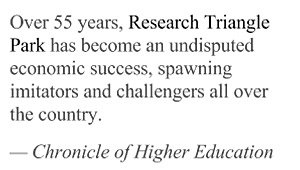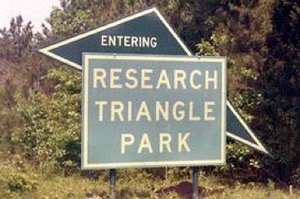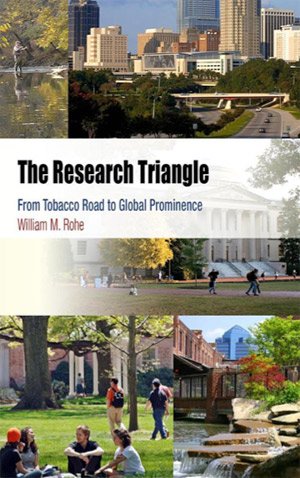To call the Research Triangle Park a national model would be an understatement. Just this month, the Chronicle of Higher Education called RTP “an undisputed economic success, spawning imitators and challengers all over the country.”[1]
It is “the king of university-affiliated business development, 11 square miles of North Carolina pine forest laced with blue-chip tenants that include IBM, Monsanto, Cisco Systems, and DuPont.”
It is also, very simply, the largest research park anywhere in North America, with more than 170 companies, 38,000 well-paid workers, and a history that includes 3,200 patents, 1,900 trademarks, and dozens of startup ventures that have grown to become major employers.
 For more than forty years, it has helped propel North Carolina’s knowledge economy in partnership with the public and private universities — North Carolina State, UNC Chapel Hill, Duke, and NC Central — that surround it. The success of RTP has brought tens of thousands of new jobs to the state, helping to create a lasting model of economic growth.
For more than forty years, it has helped propel North Carolina’s knowledge economy in partnership with the public and private universities — North Carolina State, UNC Chapel Hill, Duke, and NC Central — that surround it. The success of RTP has brought tens of thousands of new jobs to the state, helping to create a lasting model of economic growth.
“All of that occurred, that growth, because we had here a nucleus of talent, beginning with our universities,” said Bob Ingram, the former Chairman and CEO of pharmaceutical giant GlaxoWellcome. “What drives us is the collaboration with our universities. Where else — other than Boston and San Francisco — do you have that?”
For all of its ultimate success, it’s easy to forget the RTP got off to a slow start. It required disciplined, patient, and far-sighted public investment to get off the ground — the kind of investment that pays dividends for decades to come.
In the 1950s, North Carolina’s economy was almost wholly dependent on furniture, textiles, and tobacco. Each of those industries faced a difficult future, with low-cost competition threatening jobs and keeping wages low.
 The state’s business community decided to build on the strength of North Carolina’s universities to help develop a new kind of research-driven economy.
The state’s business community decided to build on the strength of North Carolina’s universities to help develop a new kind of research-driven economy.
From the beginning, the idea for RTP rested on the promise of close collaboration between business and higher education. In 1955, Governor Luther Hodges and a group of the state’s leading businessmen reached out to a UNC sociology professor named George Simpson to help get the park idea off the ground.
“Simpson realized that university cooperation would be essential for the park idea to succeed,” according to a study by Dartmouth College.[2] “So he assembled a team of faculty to develop brochures documenting the research expertise of the three universities in selected fields and to travel to visit companies and tell them about the park idea.”
The effort started slow, but RTP officials eventually landed commitments from the National Environmental Health Sciences Center and from IBM, anchoring the region’s unique identity as a place where public and private researchers come together.
In the years since, the benefits of the park have spread far beyond the people directly employed and the companies located there. “In addition to the 40,000 jobs created within the RTP, the area has experienced a number of direct and indirectly related economic benefits including construction jobs, real estate tax yields, sales tax yields and income tax yields,” according to a Duke University study.[3]
“Since 1970, greater than 1,500 companies have been established in the Triangle Region as a direct result of supporting the work done by companies inside RTP and the three associated universities,” that same study concluded.
 Though RTP has a long history with large employers, Ingram — the former GlaxoWellcome CEO who now chairs the board of the Research Triangle Foundation, which oversees the park — says its future rests with small companies that emerge from the nearby universities. “Today, startups are the engine of future science and, frankly, the engine of future economic growth,” he said.
Though RTP has a long history with large employers, Ingram — the former GlaxoWellcome CEO who now chairs the board of the Research Triangle Foundation, which oversees the park — says its future rests with small companies that emerge from the nearby universities. “Today, startups are the engine of future science and, frankly, the engine of future economic growth,” he said.
With an eye toward those companies, RTP’s next phase of development will add “town centers” of residential and retail development so that a worker at one of those startups can walk or bike to work.
“Startups don’t have their own cafeterias,” Ingram said. “We should make sure that those startups can have a very affordable place to start and to grow … where it’s conducive to that knowledge-based science worker walking out of his or her office to a Starbucks right there or to a restaurant right there and interacting with another knowledge-based worker in another startup.”
Long-range support for strong higher education and strong industry partnerships continues. University research is forming the backbone of new ventures like the American Tobacco Campus in Durham; NC State University’s Centennial Campus in Raleigh; and the Joint School of Nanoscience and Nanoengineering, a partnership between NC A&T University and UNC Greensboro.
Just as RTP helped diversify North Carolina’s economy at a critical moment in the state’s history, these new investments in university-led research are creating the next generation of high-tech, high-wage jobs.

Leave a Reply